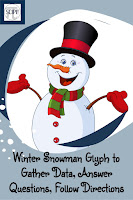Here is the list of supplies you will need:
1) A paint stick - free at most paint stores
2) A permanent marking pen
3) Something to glue at the top of the stick (You can make it, or be like me and purchase one from a craft store.)
1) A paint stick - free at most paint stores
2) A permanent marking pen
3) Something to glue at the top of the stick (You can make it, or be like me and purchase one from a craft store.)
 First, using a ruler, mark off every inch along the paint stick. I was able to make nine marks. (Notice I used the plain side of the paint stick and not the side with all of the advertising.) Now write the inches beside each corresponding mark.
First, using a ruler, mark off every inch along the paint stick. I was able to make nine marks. (Notice I used the plain side of the paint stick and not the side with all of the advertising.) Now write the inches beside each corresponding mark. When that is completed, glue the item you have chosen at the top of the stick. I really wanted to use a snowflake, but my local craft store didn't have any; so, I settled on using one of Santa's reindeer. Which one, I'm not sure since it didn't come with a name.(Hint: My husband used Gorilla Glue so the reindeer wouldn't fall off.)
When that is completed, glue the item you have chosen at the top of the stick. I really wanted to use a snowflake, but my local craft store didn't have any; so, I settled on using one of Santa's reindeer. Which one, I'm not sure since it didn't come with a name.(Hint: My husband used Gorilla Glue so the reindeer wouldn't fall off.)When it snows, venture outside and stick the Snow Measuring Tool into the snow and read the number of inches that have fallen. If it isn't exactly on an inch mark, then have your child estimate using fractional parts.
While you are measuring the snow, think about this saying: "Ten inches of snow equals one inch of rain." I am sure you have heard that claim as it is a commonly shared belief that seems to be repeated every time it snows a few feet. But, is the saying true? The immediate answer is: Sometimes.

When the temperature is around 30 degrees, one inch of liquid precipitation (rain) would fall as 10 inches of snow, presuming the storm is all snow. But, the amount of moisture in each snowflake differs depending on the temperature which in turn changes the snow to rain ratio.
For example, if a big January snowstorm occurred with colder temperatures (such as 25 degrees), the snow ratio would be closer to 15 inches of snow to one inch of rain. In fact, weathermen take this into account when forecasting how much snow a location will receive. There have been storms with snow closer to 20 degrees, moving the snow ratio closer to 20 to one. And, when it's warmer, say 35-40 degrees, the ratio moves to 5" of snow to 1" of rain.
So, after your children measure the snow in your yard with their Snow Measuring Tool, try converting the inches of snow into inches of rain based on the 10":1" ratio. By doing so, you may become your neighborhood's weather forecaster or even better, a first rate mathematician!
Your children might enjoy this snowman glyph. It's is an excellent winter activity for reading and following directions, and requires problem solving, communication, and data organization.


